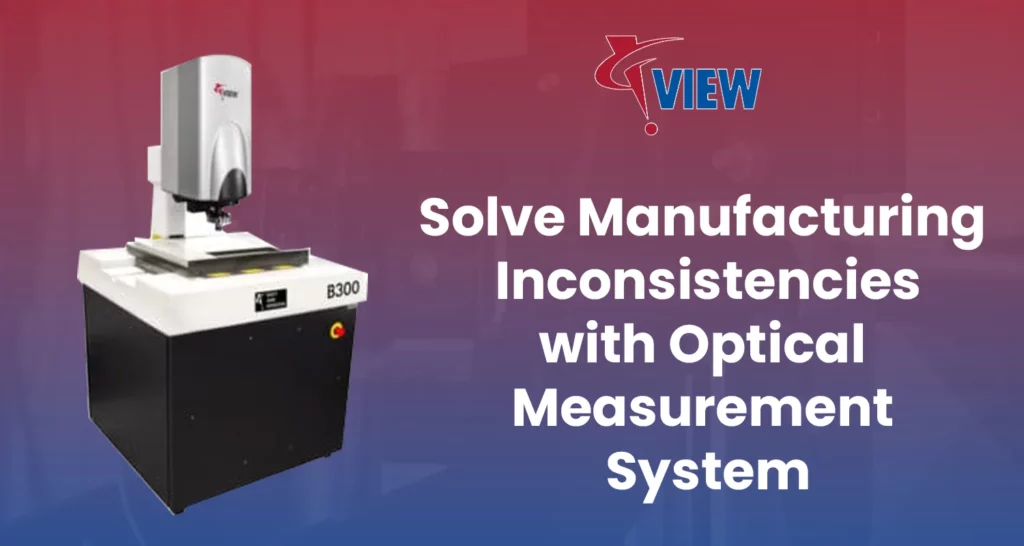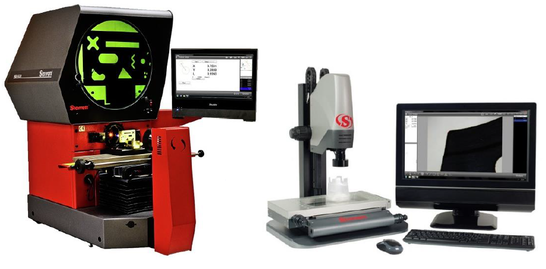How optical measurement systems optimize compliance with ISO and QA standards
How optical measurement systems optimize compliance with ISO and QA standards
Blog Article
The Role of Optical Measurement Equipments beforehand Width Methods
Optical measurement systems have transformed width, bringing a degree of precision that was once unimaginable. You could be stunned to find out exactly how these technologies, based upon basic concepts like reflection and interference, are applied across various sectors. Their non-contact capabilities not just boost precision however also simplify processes. As you discover additionally, you'll find how these systems are forming the future of measurement and top quality control.
The Advancement of Assessment: A Historic Point Of View
As you explore the history of width, you'll discover that its advancement shows mankind's quest for accuracy and standardization. From old people using body components as devices of measurement to the growth of standard weights and steps, each action shows our wish for precision. The Egyptians built the pyramids making use of exact dimensions, while the Romans advanced design with their innovative measuring tools.
Throughout the Renaissance, clinical advancements changed the focus toward a lot more empirical approaches, paving the method for contemporary width. The introduction of the metric system in the late 18th century noted a substantial milestone, establishing universal criteria. Throughout the 20th century, technical advancements additionally changed width, enabling highly precise dimensions in numerous areas.
Today, width remains to develop, integrating digital modern technology and automation. This background highlights not simply the significance of measurement but likewise our ruthless quest of enhancing precision and uniformity in our progressively intricate globe.
Concepts of Optical Dimension Equipments
Recognizing the concepts behind optical dimension systems is essential for accurate lead to metrology. You'll intend to take into consideration fundamental optical principles, measurement accuracy factors, and effective system calibration techniques. Each of these elements plays an important duty in guaranteeing your dimensions are exact and trusted.
Basic Optical Concepts
While checking out optical measurement systems, you'll encounter fundamental optical principles that develop the backbone of exact information acquisition. Light behaves in foreseeable methods, and recognizing these behaviors-- like refraction, diffraction, and reflection-- is important for effective dimensions. You'll use lenses and mirrors to manipulate light and concentrate it onto your target, guaranteeing precision in your analyses. Additionally, the wave nature of light enables interference patterns, which can enhance dimension resolution. Polarization can also play a key duty in distinguishing signal from sound, enhancing the clarity of your outcomes. By mastering these concepts, you'll be geared up to utilize optical innovations effectively, leading the method for advancements in assessment and ensuring your measurements are both reliable and repeatable.
Measurement Precision Variables
To achieve high dimension accuracy in optical systems, several variables come right into play, influencing the reliability of your results. High-grade lenses and detectors reduce aberrations and noise, ensuring your measurements are precise. By resolving these aspects, you can enhance the total performance of your optical dimension systems, leading to even more exact and reputable outcomes in your metrology applications.
System Calibration Strategies
Accomplishing high measurement precision is only part of the equation; correct system calibration methods are just as important in optical dimension systems. To guarantee your system provides dependable outcomes, you need to on a regular basis calibrate it utilizing standard recommendation products. Start by changing the optical parts, like lenses and mirrors, to minimize methodical mistakes. Next, employ known dimensions to validate the system's result and make required modifications. It's additionally important to represent ecological variables-- temperature level and humidity can affect measurements. Execute a regular calibration timetable to keep uniformity with time. Finally, document all calibration procedures and results; this will assist you track performance and attend to any type of drift in precision. With these methods, you'll improve the dependability of your optical dimension system.
Key Technologies Behind Optical Measurement
Optical dimension systems depend on numerous crucial innovations that improve accuracy and effectiveness in width. One essential technology is interferometry, which makes use of the disturbance of light waves to determine small variations and surface irregularities with severe precision. You'll also locate laser scanning systems, which record in-depth 3D data of things swiftly, making them indispensable for dimensional analysis.
In Addition, CCD and CMOS sensors play a significant duty in converting light right into electric signals, allowing for high-resolution imaging and specific dimensions. Advanced algorithms for photo processing better enhance measurement precision by evaluating information in genuine time, filtering system out noise and boosting functions.
Ultimately, fiber optics provide versatility and the ability to measure in difficult atmospheres while maintaining signal stability. By leveraging these technologies, you can accomplish premium lead to your metrology jobs, making sure that your measurements are both precise and reliable.
Applications of Optical Measurement in Sector
As industries progressively require accuracy and efficiency, the applications of optical dimension systems have actually become crucial throughout various sectors. In production, these systems help you keep an eye on measurements and tolerances in real-time, guaranteeing top quality control without taxing manual checks. In the vehicle sector, optical dimensions aid in lining up elements with accuracy, boosting safety and security and efficiency.
In electronics, you're using optical techniques to examine min functions on motherboard, detecting problems that could result in failures. The aerospace market advantages from non-destructive screening methods, permitting you to analyze products and parts without endangering their honesty.
Optical dimension additionally plays a vital duty in fabrics, making certain textile measurements fulfill precise specs. optical measurement system. With their capability to offer high-resolution data promptly, these systems encourage you to make informed decisions, improve processes, and ultimately drive development across your sector
Enhancing Precision and Effectiveness in Measurements
When you think of boosting precision in measurements, precision in your dimension strategies is necessary. By simplifying these processes, you can achieve quicker results without giving up high quality. Let's explore just how embracing sophisticated optical measurement systems can boost both accuracy and efficiency in your job.
Precision in Dimension Strategies
Accuracy in dimension strategies is vital for accomplishing trusted results in metrology, particularly considering that tiny discrepancies can lead to considerable errors. By using innovative optical dimension systems, you can boost the accuracy of your measurements. In addition, accurate measurements enable you to preserve high quality control, making sure that items fulfill rigorous specifications.
Streamlining Measurement Processes
To enhance accuracy and efficiency in measurements, streamlining your dimension procedures is crucial. Beginning by embracing optical measurement systems that supply real-time data, decreasing the time invested in hand-operated recording. These systems usually incorporate effortlessly with existing software application, enabling you to automate data collection and evaluation.
Following, standardize useful site your measurement methods. By carrying out constant procedures, you minimize variability and improve repeatability. Do not neglect to regularly adjust your devices to guarantee its accuracy.

The Influence of Optical Measurement on R & D
As researchers endeavor to push the borders of innovation, optical measurement systems have actually come to be crucial tools in page the advancement procedure. These systems give you with accurate, real-time data that improves your capacity to assess complex materials and structures. In different areas, from biotechnology to aerospace, you count on optical dimensions to improve and enhance styles product performance.

With high-resolution imaging and non-contact techniques, you can decrease example disruption, enabling even more exact outcomes. This capability to catch minute information increases your R&D cycle, letting you iterate styles rapidly and effectively. Optical measurement fosters collaboration across techniques, as the information created is commonly quickly interpretable and shareable.
Eventually, integrating optical measurement systems right into your study not just increases productivity but also grows your understanding of the sensations you research study. By leveraging these sophisticated techniques, you're far better outfitted to introduce and stay in advance in an affordable landscape.
Future Patterns in Optical Measurement Equipments
With the fast development of technology, you're most likely to see considerable shifts in optical dimension systems that will certainly redefine their application across different industries. You'll see an approach boosted automation and integration of expert system, permitting real-time data analysis and boosted accuracy. Miniaturization is an additional pattern; compact gadgets will make it possible for measurements in tighter spaces, making them excellent for fields like aerospace and biomedical applications.
Furthermore, the development of innovative materials, such as photonic crystals, will certainly enhance level of sensitivity and resolution. Expect to see systems that can run in difficult settings, supplying dependable dimensions in extreme conditions. Cloud-based analytics will certainly also play a crucial role, using you accessibility to large datasets for much better decision-making. As these technologies assemble, you'll locate that optical measurement systems not only improve accuracy but likewise simplify workflows, eventually driving technology and efficiency in your projects.
Regularly Asked Inquiries
Just How Do Optical Measurement Systems Compare to Standard Dimension Techniques?
Optical dimension systems use greater accuracy and faster outcomes compared to conventional methods. You'll try this site discover they catch more data points precisely, decreasing human error and boosting dependability, making them a favored option in different applications.
What Industries Benefit Many From Optical Measurement Systems?
You'll find industries like aerospace, automotive, and electronic devices profit most from optical dimension systems. These markets depend on exact measurements to guarantee quality and efficiency, boosting effectiveness and lowering expenses with advanced technology.

Are Optical Dimension Solutions Expensive to Implement?
Optical dimension systems can be expensive to apply, however their accuracy and effectiveness often validate the expense. Purchasing such technology can bring about considerable long-term cost savings and renovations in high quality throughout various applications.
What Abilities Are Required to Operate Optical Dimension Systems?
To run optical measurement systems, you'll need solid analytical skills, focus to detail, and efficiency in software program tools. Experience with optics and an understanding of dimension principles will additionally enhance your performance and effectiveness.
Exactly How Do Ecological Variables Affect Optical Measurements?
Ecological factors like air, moisture, and temperature level quality can distort optical measurements. You'll discover variants in precision as a result of light disturbance or refraction. optical measurement system. Preserving steady problems is crucial for specific and trusted optical measurement results
Conclusion
In summary, optical measurement systems are transforming assessment by offering unrivaled precision and effectiveness. By utilizing sophisticated principles and technologies, these systems enhance accuracy while minimizing disruptions in various sectors. As you discover future trends, you'll see exactly how the integration of AI and automation will remain to boost measurement methods, driving development and improving quality assurance. Embracing these advancements will certainly be necessary for remaining competitive and achieving quality in your area.
Accomplishing high dimension accuracy is only component of the equation; correct system calibration methods are equally crucial in optical measurement systems.When you assume regarding boosting accuracy in dimensions, precision in your dimension methods is important. By making use of advanced optical dimension systems, you can enhance the precision of your measurements.To boost precision and effectiveness in measurements, enhancing your dimension processes is essential. Exactly How Do Optical Dimension Systems Contrast to Traditional Dimension Techniques?
Report this page